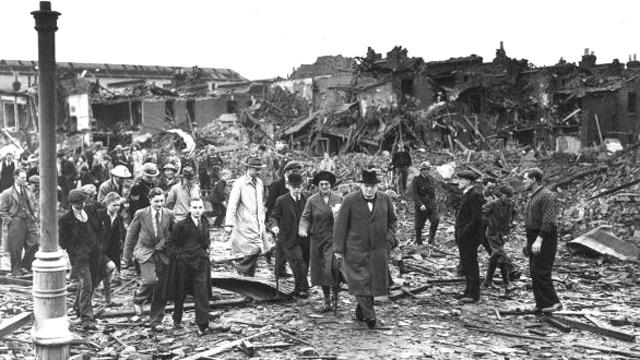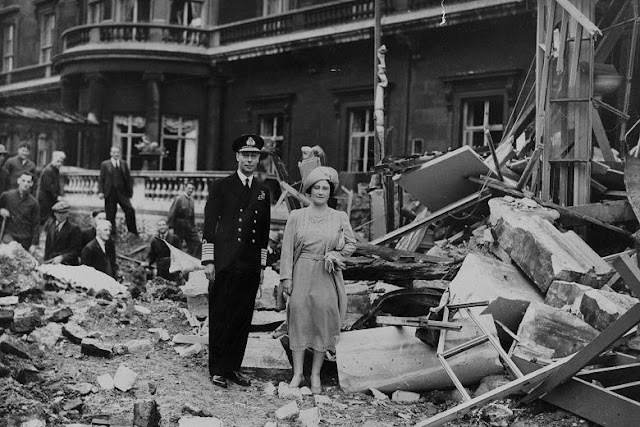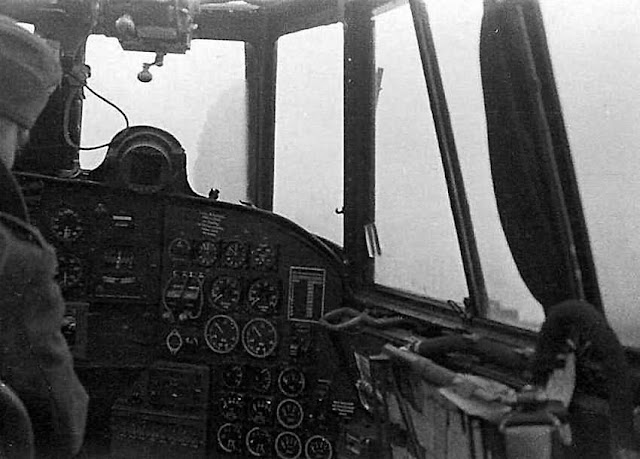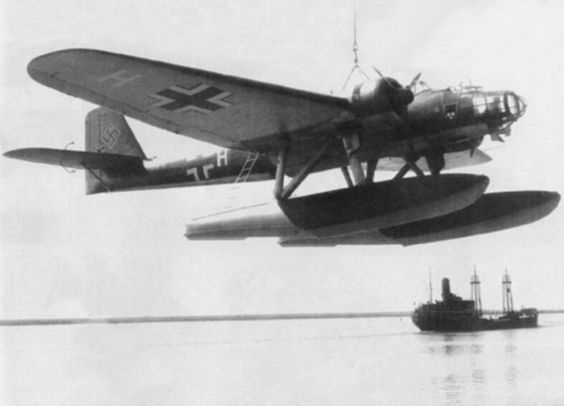Wednesday 6 November 1940
 |
| Hurricane Mk Is of No 245 Squadron, based at Aldergrove, November 1940 |
The Italian Julia Division continues being slaughtered in the Pindus sector. The Greek troops of the 2nd Army Corps continue pressing in on them. All attempts at the relief of the Italian troops in the Vovousa Valley fail.
The RAF raids Italian airfields in Albania.
The British government gives the Greek government £5,000,000.
European Air Operations: The Luftwaffe raids Southampton during the day, causing casualties and property damage. They hit two churches, one of which has 600 people sheltering in the crypt, but there are no casualties. This is estimated to be the 175th raid against Southampton. During the night, the Luftwaffe sends 190 bombers to London and surrounding areas.
During the day, RAF Bomber Command attacks a convoy off Den Helder and oil installations at Salzbergen, Cuxhaven, and the airfield at Haamstede, Zeeland. After dark, the bombers attack Spandau, Berlin and nearby locations.
Major Helmut Wick, commander of JG 2 "Richthofen," shoots down a Hurricane flown by Hubert Adair. The plane comes down at Pigeon House Farm, Widely, Hampshire. The plane is excavated on 6 October 1979 and the pilot's remains removed. His loss is listed on the Air Forces Memorial at Runnymede, Surrey.
There are dogfights over the Isle of Wight, one of which leads to the death of Ofw. Heinrich Klopp of 5./JG 2.
Overall during the day, the Luftwaffe loses about 6 planes and the RAF loses four.
Battle of the Atlantic: During the night, the Germans send seven E-boats on a sweep of the east coast of Scotland during the night. The area is heavily mined, however, and T6 hits one and sinks. The other torpedo boats then return to their base.
Italian submarine Comandante Faà di Bruno attacks Convoy HX 84. It makes a surface attack, using its deck gun, on freighter Melrose Abbey. However, its attack is unsuccessful, and the submarine, in turn, is attacked by Royal Navy destroyers HMCS Ottawa and HMS Harvester. The Faà di Bruno is sunk southwest of Ireland and all 57 aboard perish. It is an unusual situation, not just because of the brazen surface attack in the face of escorts, but because the zone of operations for Italian submarines lies much further to the south.
Royal Navy submarine HMS Sturgeon torpedoes and sinks 1294 ton Norwegian freighter Delfinus in the North Sea west of Varhaug, Jæren. Everybody survives. The Sturgeon fires two torpedoes, one of which hits the Delfinus and the other which misses and hits the beach.
In a "friendly fire" incident, Royal Navy destroyer HMS Encounter misidentifies and rams submarine HMS Utmost off Cape St. Vincent, Portugal. The submarine makes it back to port.
The Luftwaffe has a good day against shipping.
A Heinkel He 115 seaplane (KG 706) attacks Convoy WN 31 in the North Sea off Noss Head, Caithness. It bombs and sinks 6418-ton British freighter Clan Mackinlay. Five crew perish.
In the same attack, 5415-ton British freighter Harborough also is hit. Tugs take it back to port.
A Focke-Wulf Fw 200 Condor (1,/KG 40) bombs and sinks 7206-ton British freighter Nalon west of Ireland. Everyone survives.
Royal Navy 253 ton whaler HMS Sevra (T/S.Lt. Francis Brooks Richards, RNVR) hits a mine and sinks off Falmouth, Cornwall in the English Channel.
Royal Navy 63 ton trawler (drifter) HMT Girl Helen hits a mine and sinks in the North Sea off Newcastle upon Tyne, Northumberland. There are two deaths of men serving with the Royal Naval Patrol Service.
Swedish 52 ton fishing ship Elly hits an air mine and sinks in the Skagerrak about 37 km west of the Pater Noster Lighthouse. There are five deaths. It is the third Swedish fishing vessel lost to mines in the area in the past month.
Royal Navy minesweeper HMS Elgin hits a mine and is damaged. Fellow minesweeper Gossamer tows it to Harwich.
British minesweepers HMS Teviotbank and Plover, along with destroyers HMS Icarus and Impulsive, lay minefield BS 45.
Convoy FN 328 departs from Southend, Convoy FS 329 departs from Methil, Convoy BS 7 departs from Port Sudan.
Operation Coat gets underway. It is a fleet operation out of Gibraltar and part of overall Operation MB8. It is an attempt to ferry Hurricane fighters to Malta. This is the second such operation to ferry fighters (the first was Operation Hurry in August 1940). HMS Argus carries the 12 Hurricanes. The entire operation will continue over the next ten days.
At Malta, there are rumors that the BBC has broadcast that the recent air attacks on Naples have come from Malta. The bombers' base is supposed to be a secret as if the Italians believe that Malta is an offensive threat, that would make them more likely to invade it. This also is a particularly bad time to antagonize the Italians because of the extensive Royal Navy fleet operations in motion, including convoys to Malta.
Battle of the Pacific: German armed merchant cruiser Pinguin lays another 40 mines off southern Australia, this time in the Spencer Strait near Melbourne. It is now finished with its minelaying activities and departs for a rendezvous with converted minelayer Passat.
German Military: Colonel Adolf Heusinger, chief of the operations department at the army high command (OKH), submits his first draft of the proposed invasion of Greece from Bulgaria. General Franz Halder, OKH Chief of Staff, reviews it - the plan is based on his general instructions - and decides to beef up the motorized troops involved. He adds the 60 Motorized Division and the SS Adolf Hitler Division to the 40th corps which forms the backbone of the invasion. This effectively doubles its strength. He also adds 30th corps, which has to be taken from Army Group B in Poland, giving that corps the 5th and 6th mountain divisions.
In effect, Halder doubles the size of the forces involved. Taking some of these top units from forces based in Poland that otherwise would be available later for Operation Barbarossa leads some historians to reach the conclusion that this operation - which eventually becomes Operation Marita - dilutes the forces for that more important invasion.
 |
| By Illingworth, 'The Daily Mail', November 6, 1940, At Stake: "The sovereignty of the Mediterranean." |
South Africa: Former Prime Minister General J.B.M. Hertzog, who some have accused of having Hitlerite sympathies, resigns as leader of the Nationalist Party. The reason is Hertzog's loss of support by his coalition partners due to his platform of equal rights between British South Africans and Afrikaners.
Chile: The country makes a claim to some territory in the Antarctic region.
 |
| Today's papers are full of the election results. |
British Homefront: The government takes another step toward regularizing the Home Guard by authorizing the commissioning of Home Guard officers. The British Under-Secretary for War promises to provide the Home Guard troops with better equipment.
American Homefront: Professor F. Bert Farquharson at the University of Washington, who recently has completed a study of the "Galloping Gertie" Tacoma Narrows Bridge, meets with Bridge engineer Clark Eldridge and PWA engineer L. R. Durkee. Farquharson tells them that they will have to modify the brand-new bridge in order to make it more streamlined to eliminate or at least dampen a "twisting motion" which his scale models had shown were caused by high winds. The engineers agree and tell their superiors that they need to contract with suppliers to install wind deflectors on the south side of the bridge. State authorities being drafting the contracts.
 |
| Fats Waller and His Rhythm records "Tain't Nobody's Biz-Nezz If I Do." |
November 1940
November 1, 1940: Hitler Irate
November 2, 1940: U-31 Sunk - Again
November 3, 1940: Kretschmer's Master Class
November 4, 1940: Spain Absorbs Tangier
November 5, 1940: Jervis Bay Meets Admiral Scheer
November 6, 1940: San Demetrio Incident
November 7, 1940: Galloping Gertie
November 8, 1940: Italian Shakeup in Greece
November 9, 1940: Dutch Fascists March
November 10, 1940: Fala and Doc Strange
November 11, 1940: Taranto Raid
November 12, 1940: Molotov Takes Berlin
November 13, 1940: Molotov Foils Hitler
November 14, 1940: Moonlight Sonata
November 15, 1940: Warsaw Ghetto Sealed
November 16, 1940: France Keeps Battleships
November 17, 1940: Malta Hurricane Disaster
November 18, 1940: Hitler Berates Ciano
November 19, 1940: Birmingham Devastated
November 20, 1940: Hungary Joins Axis
November 21, 1940: Dies White Paper
November 22, 1940: Italians Take Korçë
November 23, 1940: U-Boat Bonanza!
November 24, 1940: Slovakia Joins In
November 25, 1940: Molotov's Demands
November 26, 1940: Bananas Be Gone
November 27, 1940: Cape Spartivento Battle
November 28, 1940: Wick Perishes
November 29, 1940: Trouble in Indochina
November 30, 1940: Lucy and Desi Marry
2020


















